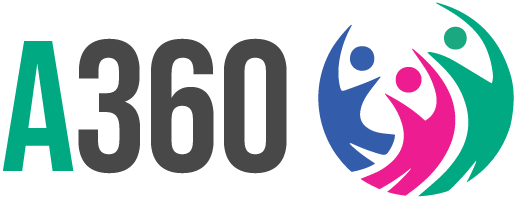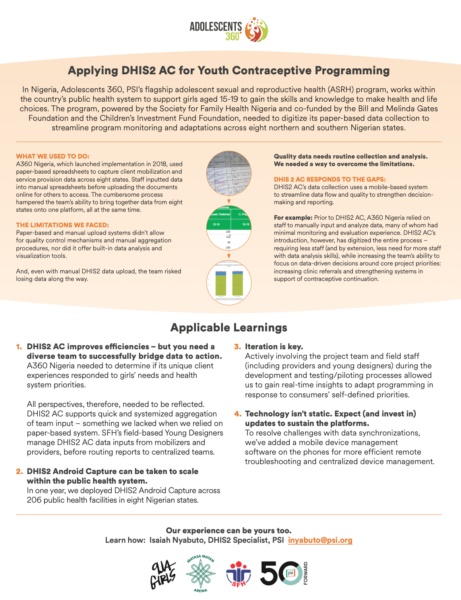We confront operational constraints when we lack efficient data monitoring tools. As a result, consumers and health systems bear the brunt when we can’t effectively track and respond to program progress and consumer behavior.
At PSI, we’ve learned that to reach better health outcomes, we must monitor demand generation and consumers’ service delivery experiences in real-time.
That’s why we’re using DHIS2 Android Capture app, a mobile-based system that allows us to monitor client mobilization, service provision and continuation of care… all from the palm of our hands. With the DHIS2 AC app, one can upload and access data at any-time, anywhere with or without internet access.
How it works:
- Interpersonal Communication Agents (IPCs) record initial client data when recruiting consumers and referring them to care.
- Once a referral is redeemed, providers record event attendance and services delivered, offering us the ability to track not only girls’ pathway to care but stay with her in her health-seeking journey following that first clinic visit.
- Through DHIS2 AC app, program assistants monitor the data, and prepares live reports submitted to facility teams allowing for prompt follow-up and service provision well after clients leave the clinic. On a global level, project indicators can be tracked through quick analyses, allowing us to quickly identify gaps and course correct, in response.
What does that look like in practice? We share, below.
Applying DHIS2 AC for Youth Contraceptive Programming
In Nigeria, Adolescents 360, PSI’s flagship adolescent sexual and reproductive health (ASRH) program, works within the country’s public health system to support girls aged 15-19 to gain the skills and knowledge to make health and life choices. The program, powered by the Society for Family Health Nigeria and co-funded by the Bill and Melinda Gates Foundation and the Children’s Investment Fund Foundation, needed to digitize its paper-based data collection to streamline program monitoring and adaptations across eight northern and southern Nigerian states.
Scale and Impact – and the Roadblocks Along the Way
A360 Nigeria’s scale called for efficient ways of collecting, managing and centralizing data while responding to girls’ needs and health system priorities.
The project, which launched implementation in 2018, used paper-based spreadsheets to capture client mobilization and service provision data across eight states. Staff inputted data into manual spreadsheets before uploading the documents online for others to access. The cumbersome process hampered the team’s ability to bring together data from eight states onto one platform, all at the same time.
Paper-based and manual upload systems didn’t allow for quality control mechanisms and manual aggregation procedures, nor did it offer built-in data analysis and visualization tools. And, even with manual DHIS2 data upload, the team risked losing data along the way.
Quality Data Needs Routine Collection and Analysis.
We needed a way to overcome the limitations.
Prior to DHIS2 AC, A360 Nigeria relied on staff to manually input and analyze data, many of whom had minimal monitoring and evaluation experience. DHIS2 AC’s introduction, however, has digitized the entire process – requiring less staff (and by extension, less need for more staff with data analysis skills), while increasing the team’s ability to focus on data-driven decisions around core project priorities: increasing clinic referrals and strengthening systems in support of contraceptive continuation.
Since introducing DHIS2 AC, we’ve trained 15 regional teams and 600 field staff to use the app. In one year, the digital health tool was deployed across 206 public health facilities in eight Nigerian states. And in six months, from July-December 2019, more than 122,000 consumers were provided with contraceptive services. During this time more than 450 client mobilization and service reports were completed and uploaded daily and submitted through the DHIS2 AC app.
Two Learnings (For Your Use, Too)
Iteration is key. Actively involving the project team and field staff during the development and testing/piloting processes provides real-time insights to adapt in response to consumers’ self-defined priorities.
Secondly, technology is not static. Investment in data updates to resolve challenges with data synchronizations is vital. We have added a mobile device management software on the phones used for data collection to facilitate efficient remote troubleshooting and centralized device management.
Thinking Beyond: The Benefits of DHIS2 AC
This innovation is easily replicable in any setting. With its use, large-scale, high-quality data is readily available for decision making and programming. It also directly contributes to better health outcomes to deliver health impact.
After all, that’s our end-goal…across the board.







